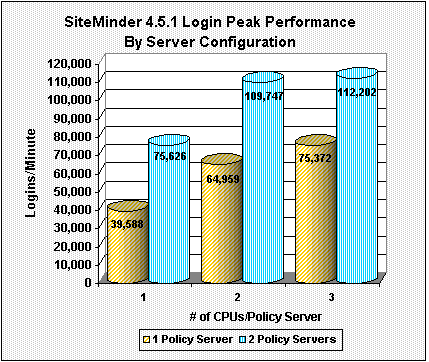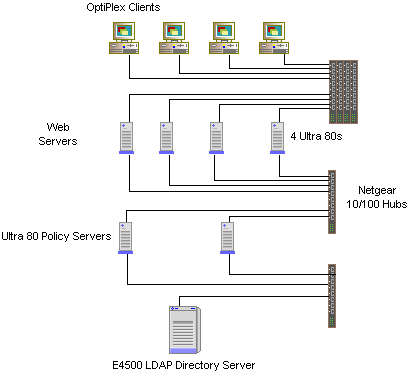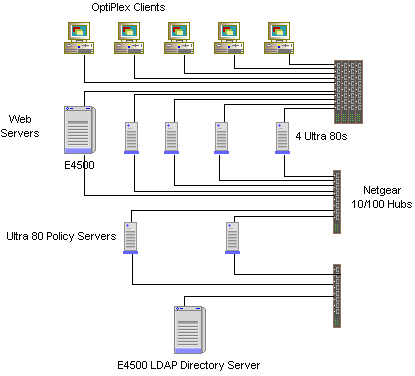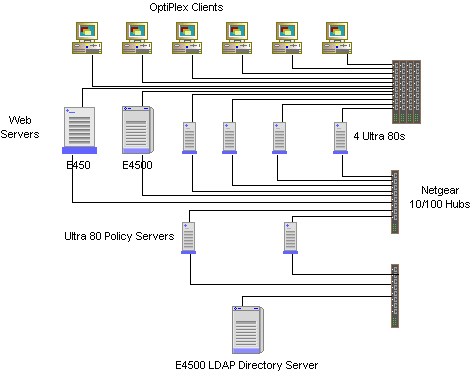 |
Netegrity SiteMinder 4.51
|
|||||||||||||||||||||||||||||||||||||||||||||||||||||||||||||||||||||||||||||||||||||||||||||||||||||||||||||||||||||||
Contents
|
Test MethodologyMindcraft® tested the performance of Netegrity SiteMinder 4.51 using our iLOAD MVP™ tool to run the AuthMark ™ Benchmark Login and Extranet Scenarios. In this section, we describe these tools so that you will be able to understand the performance results discussed in the Result Analysis section below. iLOAD MVP OverviewiLOAD MVP is a general-purpose, script-driven capacity planning, benchmarking, and regression testing tool. The major components of iLOAD MVP are:
iLOAD MVP provides the capabilities needed to test high-performance servers with a small number of client systems. Its capabilities include:
The AuthMark BenchmarkThe AuthMark Benchmark is designed to test the performance of products that provide authentication and authorization services in support of Web servers. Authentication is the process of verifying who a user is; it typically occurs when a user logs in. Authorization is the process of verifying that an authenticated user is allowed to see or to use a particular resource. In the case of a Web server such resources include HTML files, graphic files, and programs that generate Web pages dynamically. AuthMark simulates a large number of users accessing Web servers via their browsers. This approach permits AuthMark to test authentication and authorization performance independent of the technology used to provide those services. AuthMark consists of several test scenarios to determine various aspects of performance for authentication and authorization systems under different circumstances. For the SiteMinder tests we used the AuthMark Login and Extranet Scenarios. AuthMark Login ScenarioThe AuthMark Login Scenario focuses on testing authentication. We call it the Login Scenario because authentication is done the first time a user accesses a protected part of a Web site, just like a login. The HTTP 1.0 and 1.1 protocols define the steps a browser follows for authentication. Some of the steps are visible to you and others are not. It is important to understand what happens during a login in order to understand what the Login Scenario measurements mean. Login ProcessThe following simplified sequence will walk you through the login process to show you how it works using the HTTP 1.0 and 1.1 protocols:
Notice that the URL you clicked on or entered is actually sent twice (in steps 1 and 6). This means that the authentication system is used twice—first, it finds out that the requested URL requires the user be authenticated, then it processes the authorization header when the request is resent. Once a user has been authenticated, the Web browser automatically sends the authorization header whenever the user requests a URL in the same realm requiring authentication. Login Scenario ConfigurationTable 1 shows the AuthMark Login Scenario configuration parameters we used. Table 1: AuthMark Login Scenario Configuration Parameters
The number of user sessions active during a given test run is determined by the length of the test and the number of logins. Sessions are not logged out once created. Instead, each session remains quiescent after login. Running the Login ScenarioThe basic steps for running the Login Scenario are:
The Login Scenario test script selects users randomly from the user database (see Table 1 for the numbers we used for this test). The tester is free to select the number of client test systems and the number of iLOAD MVP client threads to use. These are called the load generators. The tester selects the number of load generators to get the highest performance possible from the authentication/authorization system being tested. In order to obtain the peak performance from an authentication/authorization system, the tester may need to use multiple Web servers and database servers. The tester is permitted, but not required, to do a warm-up run of the test scenario in order to get the servers to a state that would more likely represent the state they would be in during normal operation. For this benchmark, we warmed-up the servers by running the test script in its entirety. Extranet ScenarioThe Extranet Scenario is intended to simulate an environment where users must login to a Web site and where all access requests require authorization. This scenario depicts a more complete and more realistic usage pattern than the Login Scenario. The Extranet Scenario test execution starts with the same operation sequence as the Login Scenario (steps 1 - 6 above) and continues with the following operations:
SiteMinder checks the continuing validity of the authenticated user each time a resource access request is made to ensure that the user session has not been revoked. However, the user is not re-authenticated. As a result, the user does not see a new login request as long as the resources being accessed are in the Internet domain in which the user has been authenticated. The Extranet Scenario operation sequence consists of one login followed by 10 authorizations yielding a total of 11 operations per user session. We call these 11 operations an Extranet Sequence. For the Extranet Scenario, we warmed-up the servers by running the test script in its entirety. Result AnalysisThis section analyzes the Login and Extranet Scenario performance characteristics of Netegrity's SiteMinder 4.51 including its performance scalability with different server configurations. 1,000,000 User Login PerformanceThe SiteMinder Policy Server is the control point for all authentication and authorization. Our tests were structured to push the Policy Server systems as close as possible to 100% CPU utilization. Table 2 summarizes the Login Scenario performance as a function of the SiteMinder Policy Server system(s) configuration. The Scaling Factor in Table 2 shows how much faster a configuration is compared to a single system having one CPU. Table 2: SiteMinder Login Performance Scalability - 1,000,000 Users
The CPU utilizations for the Policy Server configurations with one system, three CPUs and with two systems, two and three CPUs show that we did not have enough load generators and Web servers, or fast enough ones, to drive the Policy Servers to full CPU utilization. This lack of load generators (which ran at 70% CPU utilization for the highest performance tests) and Web servers showed up for the test of the Policy Server configuration using two systems with two CPUs each even though we added a four-processor Enterprise 4500 Web server with 400 MHz CPUs to the ones we were using for the other tests. And when we used an additional Enterprise 450 with four 300 MHz CPUs for the test of two Policy Servers with three CPUs each, we still had insufficient Web server performance to drive the Policy Servers to full CPU utilization. If the lab had enough load generators and Web servers available, we fully expect that SiteMinder would have achieved more logins per minute than it did. During each of the tests, the LDAP directory server showed only 10% to 15% CPU utilization on one CPU while its other CPUs were idle. This shows that SiteMinder made very efficient use of the LDAP directory server. Figure 1 presents SiteMinder's performance from Table 2 by server configuration, with the gold columns showing the results for a single Policy Server and the blue column showing the result for dual Policy Servers. Figure 1: SiteMinder Login Scalability for 1,000,000 Users
1,000,000 User Extranet PerformanceTable 3 compares the SiteMinder Extranet Scenario performance to that of the Login Scenario for the same hardware configuration - one Policy Server with one CPU. The results in Table 3 demonstrate that the SiteMinder Policy Server performs authorizations several times faster than authentications. It is not possible to calculate the exact performance difference because the CPU utilization of the Policy Server CPU was 50% for the Extranet test and was 100% for the Login test. The CPUs in the Web servers averaged 95% utilization while the load generator CPUs averaged 70% utilization. This means that the Extranet performance would have been significantly higher, if there were enough load generators and Web servers available in the lab to drive the Policy Server's CPU to full utilization. Table 3: SiteMinder Extranet and Login Performance - 1 Policy Server with 1 CPU
ConclusionsThese test results lead us to conclude that:
Hardware Configurations TestedMindcraft used a mix of systems for the Web servers. Table 4 shows the Enterprise 450 Web server configuration we used. The Ultra 80 configurations we used for Web servers and the SiteMinder Policy server are shown in Table 5. Table 6 shows the Enterprise 4500 Web server configuration we used. Finally, Table 7 shows the Enterprise 4500 configuration we used for the LDAP directory server. Table 4: Sun Enterprise 450 Web Server Configuration
Table 5: Sun Ultra 80 Web and Policy Servers Configuration
Table 6: Sun Enterprise 4500 Web Server Configurations
Table 7: Sun Enterprise 4500 LDAP Directory Server Configuration
Figure 2 shows how the servers were configured for all of the Login Scenario tests using one Policy Server as well as the test using two Policy Servers with one CPU. Figure 3 gives the server configuration for the Login test using two Policy Servers with two CPUs. Figure 4 presents the server configuration for the Login Scenario test of two Policy Servers each with three CPU and for the one Policy Server with one CPU Extranet Scenario test. All of the systems were connected using Netgear 8 port 10/100 Base-TX hubs. Figure
2: Server Configuration for all 1 Policy Server and
Figure 3: Server Configuration for 2 Policy Servers with 2 CPUs Login Test
Figure
4: Server Configuration for 2 Policy Servers
with 3 CPUs Login Test and
Server Software Configuration and TuningWe used the following server software for these benchmark tests:
All software ran with default settings except for the following:
Client Test SystemsFor all of the tests, we used Dell OptiPlex GX 110 client test systems configured as shown in Table 8. The client test systems we used for each test are shown in Figures 2 , 3 and 4. Table 8: Client Test Systems Configuration
Changes
NOTICE: The information in this publication is subject to change without notice. MINDCRAFT, INC. SHALL NOT BE LIABLE FOR ERRORS OR OMISSIONS CONTAINED HEREIN, NOR FOR INCIDENTAL OR CONSEQUENTIAL DAMAGES RESULTING FROM THE FURNISHING, PERFORMANCE, OR USE OF THIS MATERIAL. This publication does not constitute an endorsement of the product or products that were tested. This test is not a determination of product quality or correctness, nor does it ensure compliance with any federal, state or local requirements. |
|||||||||||||||||||||||||||||||||||||||||||||||||||||||||||||||||||||||||||||||||||||||||||||||||||||||||||||||||||||||

Mindcraft is a registered trademark of Mindcraft, Inc.
Product and corporate names mentioned herein are trademarks and/or registered trademarks of their respective owners.
For more information, contact us at: info@mindcraft.com
Phone: +1 (408) 395-2404
Fax: +1 (408) 395-6324



